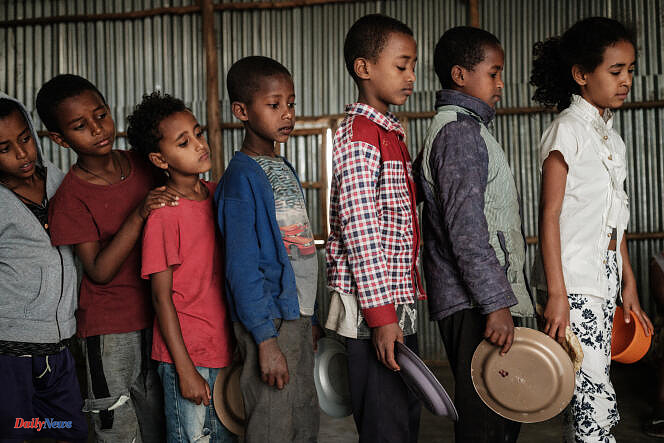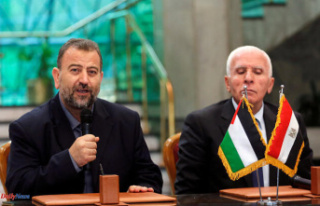The sound of weapons has stopped in Tigray and it is now hunger that kills. It killed 816 people in November and December 2023, according to the authorities in this region of northern Ethiopia. The latter are worried that the current catastrophe will eventually take on the proportions of the great famine of 1984, during which around a million Ethiopians were killed, on the same highlands in the north of the country.
Devastated by a two-year civil war (2020-2022) which left around 600,000 dead according to the African Union, Tigray and its 6 million inhabitants today face a much more insidious threat. “More than 2 million Tigrayans are in a situation of acute malnutrition due to drought and lack of food aid,” assures Gebrehiwot Ghebreigzabhier, who heads the regional humanitarian action office and who considers himself “overwhelmed” by the scale of the tragedy.
East Africa as a whole is experiencing its worst drought in four decades, despite the recent episode of flooding linked to the El Niño weather phenomenon in November. Tigray, a rocky region accustomed to episodes of extreme aridity, missed the last rainy season. Almost half of the province did not receive any precipitation in summer: 141,000 hectares of crops have already suffered and harvests are expected to be minimal. A disaster for this agrarian society, now condemned to wait until June before the next rains.
Vast embezzlement scandal
But the humanitarian drama playing out in Tigray is not only linked to the drought and the destruction left by the war. The region is also deprived of food aid. The United Nations World Food Program (WFP) and the American development agency USAID suspended their food distributions in the country between June and mid-December after the discovery of a vast embezzlement scandal orchestrated by the Ethiopian authorities. With 29 million Ethiopians – a quarter of the country’s population – in need of humanitarian assistance according to UN data, Ethiopia is the largest recipient of US food aid in the world.
Distributions resumed at Christmas, but “they represent only a fraction of what is required,” wrote Getachew Reda, the president of the Tigray region, in an open letter on December 29. WFP is only delivering around 20% of the required aid as it is testing a new allocation process, where national authorities no longer draw up beneficiary lists or monitor warehouses to avoid flights. At the same time, “thousands of Tigrayans have died of hunger” for six months, says Getachew Reda, according to whom 91% of the Tigrayan population requires humanitarian assistance that his administration does not have the means to provide.
“These areas were the main battlefields during the war, they still bear the marks, infrastructure was destroyed and farms were pillaged by the enemy. In addition, they did not receive any rain last summer. I cannot describe the life of the inhabitants to you. It's indescribable. All are malnourished, their fields are scorched and their livestock are dead. They no longer expect anything from the Ethiopian authorities and are losing hope towards international NGOs,” he describes. Shewit Wudasie says he expects “thousands more deaths” in the event of the status quo.
“Unacceptable propaganda”
But the federal government in Addis Ababa remains deaf to these calls for help. The declaration of “famine” by the president of Tigray, Getachew Reda, even provokes the ire of Addis Ababa. Ethiopian authorities refute the term, accusing Tigray of wanting to “politicize the crisis.” In Ethiopian history, whether in 1973 under Emperor Haile Selassie or in 1984 under the “Red Negus” Mengistu Haile Mariam, episodes of famine have had disastrous consequences for the regimes in place, accused of using food aid as a political lever and to impose humanitarian blockades to combat insurgent movements.
However, Prime Minister Abiy Ahmed had moved closer to the Tigrayan authorities after the Pretoria peace agreement in November 2022, which ended the civil war. But anxious to preserve its image, Addis Ababa describes the calls from Tigray as “unacceptable propaganda”. “Comparisons with the famine of the 1980s are completely wrong,” said government spokesperson Legesse Tulu. The Ethiopian authorities did not respond to requests from Le Monde.
The international organization Famine Early Warning System Network (Fewsnet), however, announces that “the state of food emergency could extend to the entire Tigray province at the beginning of 2024”, as well as to areas of the neighboring Amhara region. , due to poor agricultural yields and poor food distributions. Another danger emerges. Tigray, Ethiopia and the rest of the Horn of Africa risk being victims of the gradual disengagement of international humanitarian partners from the region. Humanitarian organizations are now focusing on other crises, like Gaza. By 2023, only 33.5% of the $4 billion requested by the United Nations in its humanitarian response plan for Ethiopia has been funded.












